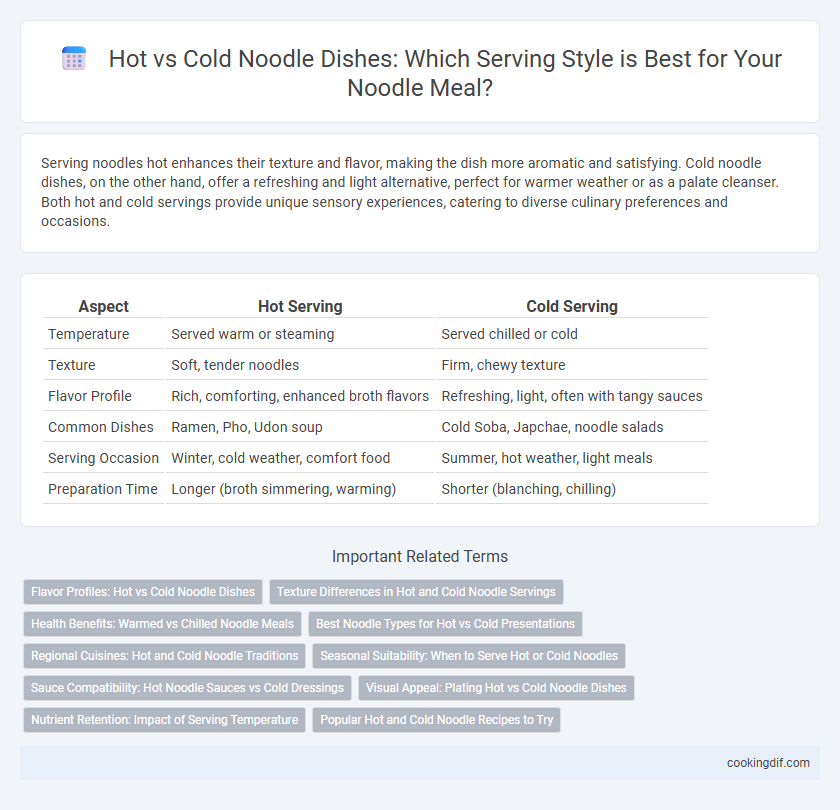Serving noodles hot enhances their texture and flavor, making the dish more aromatic and satisfying. Cold noodle dishes, on the other hand, offer a refreshing and light alternative, perfect for warmer weather or as a palate cleanser. Both hot and cold servings provide unique sensory experiences, catering to diverse culinary preferences and occasions.
Table of Comparison
| Aspect | Hot Serving | Cold Serving |
|---|---|---|
| Temperature | Served warm or steaming | Served chilled or cold |
| Texture | Soft, tender noodles | Firm, chewy texture |
| Flavor Profile | Rich, comforting, enhanced broth flavors | Refreshing, light, often with tangy sauces |
| Common Dishes | Ramen, Pho, Udon soup | Cold Soba, Japchae, noodle salads |
| Serving Occasion | Winter, cold weather, comfort food | Summer, hot weather, light meals |
| Preparation Time | Longer (broth simmering, warming) | Shorter (blanching, chilling) |
Flavor Profiles: Hot vs Cold Noodle Dishes
Hot noodle dishes release aromatic spices and enhance the umami depth, creating a rich, comforting flavor profile. Cold noodle dishes offer a refreshing crispness, intensifying bright, tangy, and herbaceous notes. Temperature significantly influences texture and taste perception, with warmth amplifying savory elements and cold emphasizing freshness and subtle nuances.
Texture Differences in Hot and Cold Noodle Servings
Hot noodle dishes offer a soft and tender texture as the heat helps to break down starches, creating a smooth and pliable bite. Cold noodle servings maintain a firmer, chewier texture due to the noodles cooling and tightening, which enhances their elasticity. This contrast in texture significantly impacts the overall eating experience, with hot noodles providing comfort and cold noodles delivering a refreshing bite.
Health Benefits: Warmed vs Chilled Noodle Meals
Warm noodle dishes enhance digestion by stimulating gastric enzymes and improving nutrient absorption, contributing to better gut health. Chilled noodle meals offer a refreshing hydration boost and lower glycemic response, which aids in blood sugar management. Both serving methods support distinct metabolic benefits based on temperature and meal composition.
Best Noodle Types for Hot vs Cold Presentations
Wheat-based noodles such as udon and ramen excel in hot dishes due to their thick, chewy texture that holds up well under heat and absorbs broths effectively. In contrast, buckwheat soba noodles and rice vermicelli are ideal for cold presentations, offering a light, refreshing bite that pairs well with chilled sauces and salads. Choosing the right noodle type enhances the dish's overall flavor profile and texture, optimizing the dining experience whether served hot or cold.
Regional Cuisines: Hot and Cold Noodle Traditions
In Asian regional cuisines, hot noodle dishes such as Japanese ramen and Vietnamese pho emphasize rich broths and freshly cooked noodles to enhance warmth and comfort. In contrast, cold noodle traditions like Korean naengmyeon and Chinese liangpi focus on refreshing, chilled textures and tangy, spicy sauces ideal for hot climates. These regional variations highlight the cultural adaptations of noodles to local temperatures and ingredient availability.
Seasonal Suitability: When to Serve Hot or Cold Noodles
Hot noodles are ideal for colder seasons, providing warmth and comfort with broths or spicy sauces that enhance the dining experience during fall and winter. Cold noodles, often served with refreshing vegetables and tangy dressings, are perfect for hot summer months, helping to cool down the body and offer a light, revitalizing meal. Seasonal suitability influences ingredient choices and preparation methods, ensuring noodles align with temperature preferences and nutritional needs throughout the year.
Sauce Compatibility: Hot Noodle Sauces vs Cold Dressings
Hot noodle sauces like marinara, Alfredo, and spicy chili oil better adhere to warm noodles, enhancing flavor absorption and creating a cohesive dish. Cold dressings such as sesame vinaigrette, soy-based sauces, and citrus-infused oils work well with chilled or room-temperature noodles, providing a refreshing contrast and preserving the noodles' firmness. Sauce compatibility is key to either enriching the noodle's texture with heat or maintaining a crisp, light bite when served cold.
Visual Appeal: Plating Hot vs Cold Noodle Dishes
Hot noodle dishes often feature steam rising from the bowl, enhancing visual appeal through vibrant broth colors and glistening ingredients that create a sense of warmth and freshness. Cold noodle dishes emphasize crisp textures and glossy, chilled noodles, frequently adorned with bright garnishes like thinly sliced vegetables and herbs for a refreshing, clean presentation. The contrast between the warm, inviting hues of hot noodles and the cool, vibrant tones of cold servings plays a crucial role in attracting diners visually.
Nutrient Retention: Impact of Serving Temperature
Hot serving of noodle dishes enhances digestibility and can improve the bioavailability of certain nutrients like beta-carotene and antioxidants, which are more easily absorbed when heated. Cold serving, while refreshing, may preserve heat-sensitive vitamins such as vitamin C and some B vitamins that degrade at higher temperatures. The impact of serving temperature on nutrient retention varies by specific nutrients and cooking methods used prior to serving.
Popular Hot and Cold Noodle Recipes to Try
Hot noodle dishes like ramen and pho offer rich, savory broths that enhance the noodles' texture and flavor, making them perfect for warming meals. Cold noodle recipes such as soba and naengmyeon provide refreshing tastes with light, tangy dressings ideal for hot weather or light lunches. Both serving styles highlight diverse textures and flavor profiles, catering to varied culinary preferences and seasonal needs.
Hot serving vs cold serving for noodle dish Infographic

 cookingdif.com
cookingdif.com